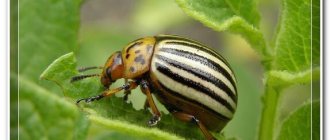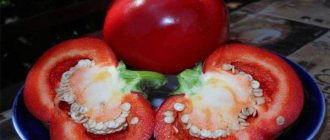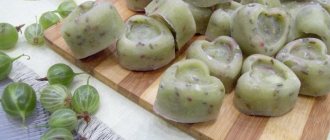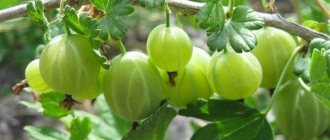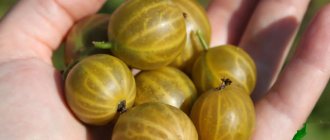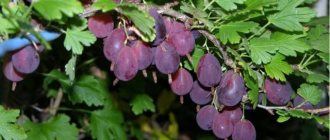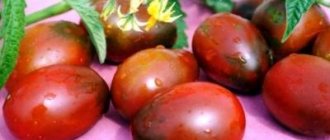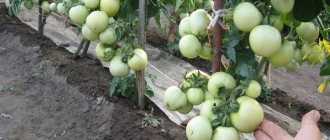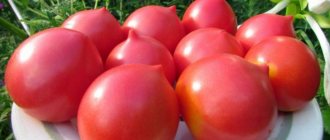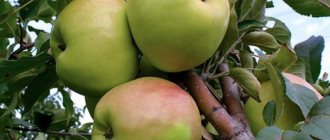Who is it suitable for?
Even a novice gardener can start growing the Kolobok variety. This gooseberry does not require specific care. It is enough to choose the right place for planting and provide systematic watering.
Important! Minor frosts will not cause serious harm to the bush, but it will not be able to recover after a sharp temperature change.
This gooseberry variety is intended primarily for the central regions of the country. It is worth noting that Kolobok can be found throughout the territory. If you provide it with proper care and shelter from the cold, you can also get a gooseberry harvest in the northern regions.
Diseases and pests
The Kolobok variety is rarely affected by any diseases. Most often these are fungal infections, which are controlled with fungicides. It should be remembered that they are not recommended for use during the period of active fruiting. If necessary, use drugs with biological effects on fungi. For example, phytosporin. After processing, the berries can be eaten after 5-7 days.
To combat aphids and sawflies, folk recipes and chemicals are used. For preventive purposes, bushes are sprayed with boiling water in early spring.
Characteristics of the variety
Gooseberry Kolobok is considered one of the mid-season varieties. The gardener can have a harvest by mid-summer. The plant forms a spreading, powerful bush up to one and a half meters high. The branches have a small number of thorns, which are located at the nodes.
The buds are voluminous and brown. Gooseberry leaves are located on short petioles. They have smooth outlines. Kolobok's foliage is rich green with colored veins.
Features of Kolobok berries
Below we list the main characteristics of Kolobok berries:
- dense skin of rich red color;
- weight from 3-4 to 7 g;
- round or slightly elongated shape;
- juicy, slightly crispy flesh;
- small seeds;
- nice smell;
- sweet and sour taste;
- light waxy coating.
If we consider the chemical composition of the Kolobok gooseberry berries, it contains ascorbic acid, anthocyanins, and sugars. The pulp has a pleasant, sweet and sour taste. During picking, the berries are easily separated from the branch. A small number of thorns on the bush is also an advantage when picking fruit.
Reviews
This variety has been growing in the country for a long time. Unpretentious, resistant to powdery mildew, productive. The branches are very thin and long, under the weight of a large harvest they fall to the ground - support is required. This is Kolobok's biggest drawback.
Nikolay, Moscow region
The berries are large, but there are larger varieties. On the plus side, good resistance to anthracnose and powdery mildew, few thorns. The taste is quite simple, without a strong aroma, like older gooseberry varieties.
Valentina, Tula
At the dacha I try to grow only pesticide-free products. I select the most resistant varieties. Kolobok allows you to do without spraying even against anthracnose and powdery mildew, with the exception of seasons with very wet weather. The taste is 4.5, as written in the variety description: the berries are large, sweet, the skin is thin. But support for the bushes is required, otherwise branches with berries will fall to the ground.
Vera Petrovna, Nizhny Novgorod
Choosing a location on the site
In order for the Kolobok gooseberry to bear fruit well, you need to plant the cuttings in a suitable place. The main requirements are sufficient illumination, soil composition and moderate distance from groundwater.
The best platform for Kolobok
Gooseberries can be planted in a place where legumes, potatoes or beets previously grew. But in the area where raspberries or currants were previously located, Kolobok should not be planted.
Important! The ideal place for planting shrubs is a spacious, well-lit place.
The best place for gooseberries is a free, well-lit area. If there is no such area for the seedling in the garden, a place in partial shade will do.
Soil moisture
The second important factor is the proximity of groundwater. Although Kolobok gooseberries require regular watering, excess moisture can provoke fungal diseases in the plant. If the groundwater is less than two meters deep, an embankment will need to be prepared before planting the bush.
Soil composition
There are a number of requirements for soil composition. In order for the Kolobok gooseberry to bear fruit well, the soil must be:
- neutral/slightly acidic;
- loose;
- fertilized.
After planting the plant, soil moisture should be monitored. When it rains periodically, this will be enough for the bush to grow. If the summer is dry, the gooseberries will have to be watered.
Growing gooseberries Kolobok
We recommend reading our other articles
- Planting cucumbers in open ground
- Percheron horse breed
- How to shear sheep correctly
- When to Harvest Onions
In areas with temperate and temperate continental climates, Kolobok gooseberries grow without problems. And if you provide it with proper care, then even in colder regions it will be able to produce large harvests.
A newly planted bush is well watered even in rainy weather.
- As the bush grows, it is necessary to loosen the soil under it and mulch it. As soon as the mulch begins to rot, it is removed, the ground is loosened, and after 1-3 days the mulch is laid again. This will ensure regular nutrition and improve the soil composition. It is recommended to lay mulch throughout the summer to prevent moisture from evaporating. You can also lay it for the winter, but this will be discussed below.
- Water the bush as needed. The earth should not crack from dryness! But swamps under the bush should not be allowed either. Usually, if there is insufficient precipitation, abundant watering is carried out 1-2 times a month.
Important!
Kolobok is a vigorous variety of gooseberry. If you don't prune it, it will become a huge bush in a matter of years. And although it does not have many thorns, it will not be easy to harvest. So don’t neglect pruning!
- Kolobok gooseberries are fertilized from 3 years after planting (if the land was initially fertilized). Minerals are added to the gooseberries in the spring (to activate growth), and organic matter in the winter. The latter is brought in for digging once every 2 years, not more often. Minerals can be added every season. Sometimes they are applied in the summer, except in spring, if, for example, the bush is sick or if there is too much harvest.
- To prevent the bush from growing too much in all directions, the crown is regularly shaped. It is better to do this 1-2 times a year than later, when the bush grows, it will be pricked by thorns that prevent you from getting close to the berries. Sick, old and damaged branches are removed, leaving only young, strong ones.
- The gooseberry variety Kolobok is resistant to powdery mildew, but it can suffer from mosaic or be affected by pests such as moths, aphids and others. At the first sign, you should use insecticides or fungicides. It’s better to stop the problem right away than to lose an entire bush later.
- For the winter, the bush must be insulated so that it does not freeze out. To do this, it is enough to sprinkle mulch into the root zone up to 25 cm thick. If the bush is small, you can cover it with insulating material, but this is not necessary.
Planting process
In the place chosen for the gooseberries, dig a hole about the size of a bucket. If the bush is planted in the fall, it needs to be prepared a couple of weeks before planting. In spring, it is enough to dig a hole in a week.
Important! When planting several gooseberry bushes, a distance of one and a half meters should be left between them.
It is recommended to place a small amount of ash or humus at the bottom. When planting in spring, you can also add potassium sulfate and superphosphate. The seedling is immersed vertically into the recess until branching begins. Next, you should carefully straighten the roots. After they have been laid, they begin to cover them with earth. It is important to prevent the formation of cavities. During the filling process, it is recommended to compact the soil periodically.
After planting is completed, the gooseberry bush is watered generously. Then the branches are pruned so that about five developed buds remain on each. The soil around the trunk is fertilized with humus. This reduces the evaporation of moisture from the soil. This measure also prevents the formation of a crust on the surface.
Seedling preparation
In order for a seedling to quickly take root and subsequently bear fruit abundantly, it needs enough nutrients. Therefore, before planting, its roots should be kept in a solution of sodium humate (3 tablespoons per 5 liters of water is enough).
Ginger - what kind of plant is it and what does it look like: photo and description
The ideal newcomer to the garden plot will be a young seedling with a well-developed root system. If dry branches are visible on the bush, cut them off before planting.
Plant care
In order for the plant to develop properly, it requires proper care. Gooseberry Kolobok requires regular pruning.
As a result of removing some branches, the bush is better illuminated. This measure also helps prevent excessive thickening and promotes better fruiting.
Important! Branches that are no more than two years old bear fruit best.
One of the features of the Kolobok gooseberry is its tendency to overgrow. Therefore, pruning of branches begins immediately after transplanting the plant.
Description of re-trimming
Repeated pruning of the Kolobok is carried out every other year in the spring. You will need to remove branches that have grown directly above the ground. It is also worth trimming weak shoots that have not grown to 20 cm in length.
Subsequently, pruning will also be required. This removes:
- branches growing directly above the soil;
- tips of overgrown shoots;
- shoots that make the crown too thick;
- damaged and weakened branches;
- basal shoots.
If you regularly thin out the bush, the fruiting branches will have enough sunlight. It is also necessary to remove root shoots so that more moisture and nutrients flow to the trunk. With this approach, the Kolobok gooseberry bears fruit abundantly for 10-15 years.
However, caring for a planted plant is not limited to pruning. The soil next to the Kolobok gooseberry is required regularly:
- water;
- feed;
- loosen.
Watering is only relevant in dry summers. As already mentioned, excess moisture can cause fungal diseases or root rot.
If a gardener plans to plant several gooseberry bushes at once, it is recommended to prepare a drip irrigation system. However, when planting one or two plants, such a measure will not be advisable.
Loosening and removing weeds
Immediately after watering, it is recommended to carry out two more procedures: removing weeds and loosening. At the same time, it is important not to injure the root system of the Kolobok gooseberry. After moistening, the soil becomes softer and more elastic, so weeding and loosening are carried out after watering.
Fertilizer application
It is recommended to fertilize the soil during planting. The plant's initial supply of nutrients will last for three years. In the fourth year, a fertilizer complex should be added to maintain high productivity. Includes:
- compost;
- ammonium sulfate;
- superphosphate;
- potassium sulfate.
The ratio of ingredients is as follows: for 5 kg of compost, 25 g of ammonium sulfate and potassium sulfate and 50 g of superphosphate. This composition is placed directly under the bush and slammed down.
Varietal features
Kolobok has characteristic features that distinguish it from other varieties of gooseberries.
Fruiting
Flowering occurs at the end of April. Within 2-2.5 months, large ripe berries are formed in place of light green flowers. Harvest occurs in mid-summer.
With proper agronomy, the bush begins to bear fruit after 2-3 years of growth. It is mid-season, high-yielding. In favorable growing conditions, up to 10 kg of ripe gooseberries can be harvested from one bush per season. The fruits are easily removed from the branch.
Important! The shoots, strewn with ripe berries, bend towards the ground. Because of this, part of the crop may rot
In such cases, tying the bush is recommended.
Refers to table species. In terms of organoleptic properties, the berries received 4.5 points out of a possible 5. They have a sweet taste with a slight sourness and a pronounced fruity aroma. In addition to fiber, they contain sugar, pectins, and ascorbic acid.
Freshly harvested Kolobok
The skin of the fruit is dense and does not crack when pressed, so gooseberries are well suited for transportation.
Frost and drought resistance
Has excellent frost resistance. Tolerates low air temperatures and frosts down to -20°C. In areas with harsh, long winters, gooseberry bushes are covered with agricultural fiber, burlap, and spruce branches.
Sensitive to sudden temperature changes. Therefore, in areas with unstable cold weather, Kolobok is additionally protected with covering materials.
Gooseberries require regular watering. Calmly tolerates short-term drought. Prolonged lack of moisture leads to a decrease in the number and size of berries and their shedding.
Resistance to diseases and pests
A healthy plant has good immunity to diseases and pests. Therefore, Kolobok does not create any special problems for the gardener.
Violation of cultivation technology, lack of nutrients, waterlogging of the soil lead to damage by fungal diseases (white spot, glass rust) and insects (caterpillars, aphids). I treat sick plants with fungicides and special preparations.
Important! Heavily infected bushes are dug up and burned
Use of berries
Kolobok is grown for personal use, industrial production of jams, compotes and for sale. Berries picked at the stage of technical ripeness are perfectly preserved and transported.
Advantages
This is the reward that awaits the gardener after harvesting the gooseberries.
Among the advantages of the variety are:
- high level of adaptation;
- rapid ripening;
- a small number of thorns;
- high level of productivity;
- good taste;
- pleasant rich aroma;
- ease of care.
At the same time, Kolobok is afraid of drought, so constant humidity control is required. But it also overgrows quickly, which requires constant pruning. In addition, the culture reacts sensitively to sudden temperature changes.
